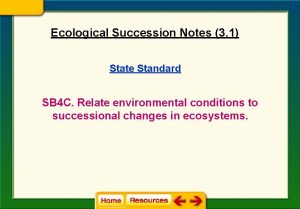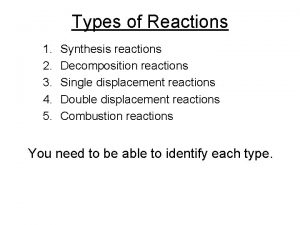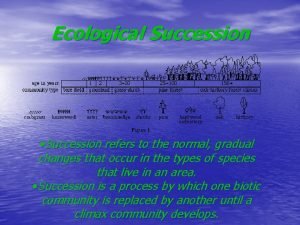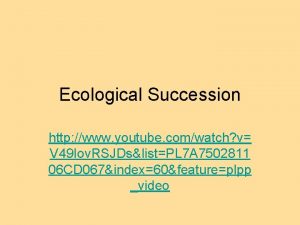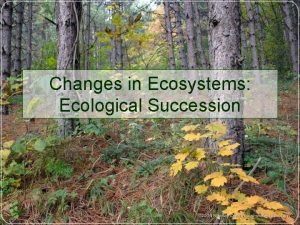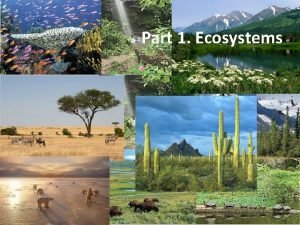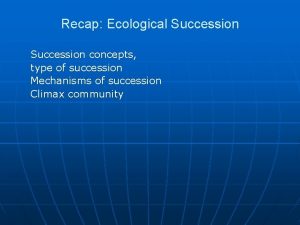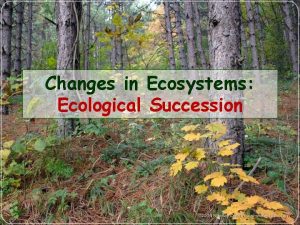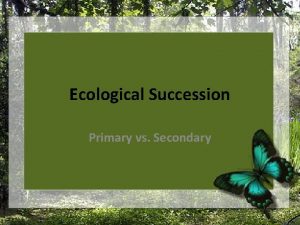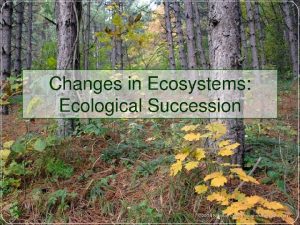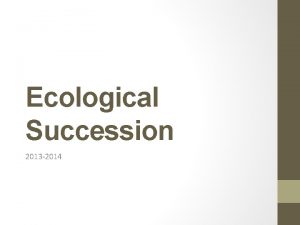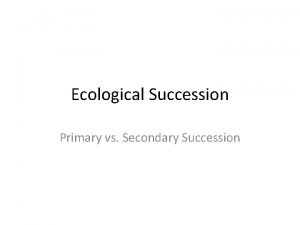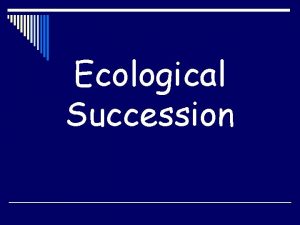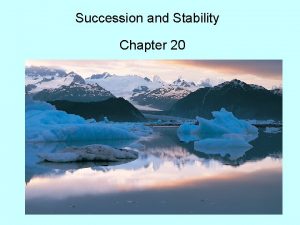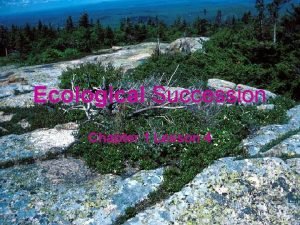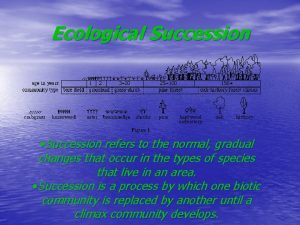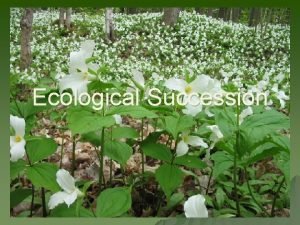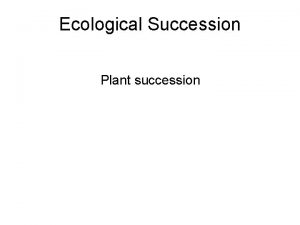SUCCESSION Ecological succession is the gradual replacement of













- Slides: 13

SUCCESSION Ecological succession is the gradual replacement of an older generation of a species by younger organisms Succession is followed by any disturbance in an ecosystem. A disturbance could include hurricanes, earthquakes, fires, or human activity such as clearing of land for farming or building.

TYPES OF SUCCESSION: 1. Primary succession is the gradual development of a new community from nothing. § a. No soil = no plant or animal life § b. Ex: Volcanic eruptions, receding glacier, or island formations 2. Secondary succession occurs when a disturbance changes or partially destroys an ecosystem, but leaves the soil § a. Abandoning a farmland or or a forest fire leads to secondary succession

PRIMARY SUCCESSION: Primary succession usually follows a volcanic eruption and depends on the creation of soil. Any of the first species to move into a devastated area = pioneer species A common pioneer species = lichen Lichens = symbiotic organisms consisting of fungus and algae § Lichens = produce acid to breakdown rock to form soil

PRIMARY SUCCESSION PROGRESSION: 1. Bare rock with no soil 2. Lichens (pioneer species) breakdown rocks to form soil 3. Grasses (shallow root) and other small plants grow forming even more soil 4. Shrubs (deeper root) and trees grow as amount of soil increases 5. Different animal populations move in as the plant community changes Lichens grasses shrubs trees (climax community)


SECONDARY SUCCESSION Secondary succession occurs when a disturbance changes or partially destroys an ecosystem, but leaves the soil a. Abandoning a farmland or b. Fires leads to secondary succession Secondary succession happens faster than primary succession Soil and sometimes plants are already present so plants can grow without waiting for soil to be created

This Photo by Unknown Author is licensed under CC BY-SA-NC

SECONDARY SUCCESSION: A climax community develops as succession slows in an ecosystem Climax community = stable community formed at the end of ecological succession Stable climax communities do not last forever: a disturbance such as hurricane may disrupt them and restart the process of succession.

POND SUCCESSION

PRACTICE PAGE 11 -12 Part I succession – 1. . Secondary plants don’t have to wait on soil to be created. 1. . 2. . Part II Climax community is the stable community at the end of succession. 6. . 7. . At the end 8. . Lichens grass shrubs trees eruptions 9. Volcanic. 10. . Forest fires, hurricanes, Lichen and moss growing on rocks created by volcanic eruption. Grass and shrubs growing after a forest has been burned down. human activity is a fungus/alga that creates soil. 3. Lichen. Pioneer species is the first species to live in a new 4. ecosystem. . An example is lichen and moss.

AGREE/DISAGREE 1. 2. 3. 4. Hardwood trees are the pioneer species in this ecosystem. The annual plants represent the climax community. Softwood trees are replaced by shrubs in this ecosystem A forest fire that burns down the hardwood trees would lead to primary succession in this ecosystem.

SILENTLY CLEAR DESK FOR EXIT TICKET

EXIT TICKET Part I 1. 2. 3. 4. 5. 6. 7. 8. . D. A A. . B. B. C. D. A Part II 9. . B 10. . D 11. . F 12. . D 13. . A 14. . A 15. . C 16. . B 17. . B 18. . A 19. B 20. B 21. A
 Ecological succession succession of a pond
Ecological succession succession of a pond Ecological succession succession of a pond
Ecological succession succession of a pond Na o cl
Na o cl Ecological succession refers to
Ecological succession refers to Youtube ecological succession
Youtube ecological succession Primary succession stages
Primary succession stages Ecosystem objectives
Ecosystem objectives Secondary succession facts
Secondary succession facts If there is no struggle there is no progress examples
If there is no struggle there is no progress examples Jessica gurevitch
Jessica gurevitch Texas gateway ecological succession
Texas gateway ecological succession Primary vs. secondary succession
Primary vs. secondary succession Primary succession
Primary succession Flow energy review
Flow energy review

